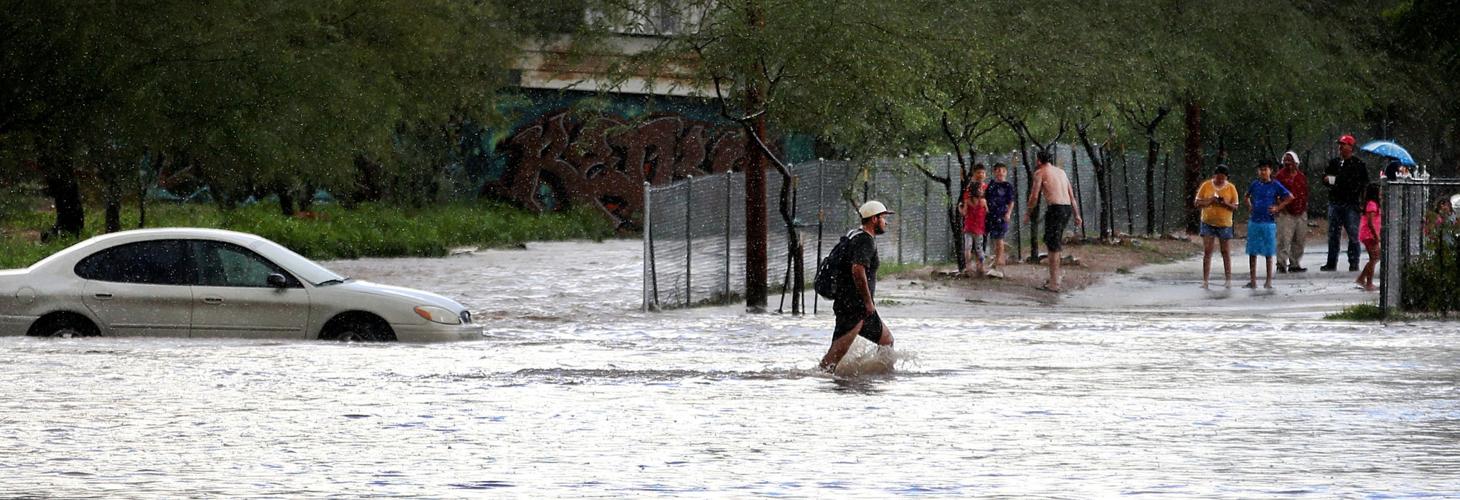People knew Houston was vulnerable to flooding — just like they know Tucson is vulnerable to heat, flooding, fire.
A hurricane would come ashore pushing a massive storm surge of ocean water, forecasters predicted. That would mix with heavy rain, and catastrophic flooding would ensue.
But a stalled tropical storm dropping 30, 40, or even 50 inches of rain without any significant storm surge? That was not even imagined in Houston’s dystopian handbook — an analysis called Hell and High Water, published by ProPublica and the Texas Tribune last year.
The experts cited in that report foresaw storm surge as the major source of flooding in Houston under a warmer global climate.
So what does that tell us in Tucson? The extreme weather we experience as the planet warms could be beyond our imagining.
Picture a month of 115-plus temperatures in summer. A winter when the high temperatures don’t drop below 80 and wildfires burn. A tropical storm from the Pacific that comes up the gulf, stalls and drops 10 inches of rain on us.
I just made these scenarios up, but they’re the kind of thing just beyond our currently realistic fears that could become reality. The same way an unimaginable 50-inch Houston rainfall did. The way that this June was the hottest on record in Tucson, and was followed by a July that was the wettest ever recorded here.
“Extreme heat, precipitation intensity — those things are changing,” UA atmospheric scientist and associate professor Christopher Castro told me Tuesday. “They’re changing in such a way that we might experience things that we don’t have a historical precedent for.”
“We might get a 120-degree day in Tucson,” Castro said. “We might get an extreme precipitation event in Phoenix that is a 1-in-1,000-year event, but we might get that several years in a row.”
That’s the thing about our usual expectations: They’re based on past experience.
As Hurricane Harvey showed, past experience no longer puts guardrails on what we can expect in the future. We’re hurtling over them into a future of unknown extremes.
In Tucson, we can at least guess which natural threats to worry about. Extreme heat is the obvious one here. Tuesday’s high temperature, by the way, was a record — 106 degrees, the 13th record-high temperature of the year. Expect more.
Extreme rain is another. Every 1-degree Celsius increase in the air temperature increases its capacity to hold water by 7 percent, Castro noted. Earlier this year, he and a colleague published research suggesting that monsoon storms are becoming less frequent but more intense.
Another threat: wildfires. As we’ve seen this year, big rains lead to a burst of growth in the deserts and forests, which become tinder for wildfires when the rain stops and record heat sets in.
The wildfires themselves can interact with the rains to make flooding worse, as Pima County Flood Control director Suzanne Shields told me. Plants no longer hold the soil, which turns into a speedy exit ramp for floodwaters.
“The wild card for us will be what happens if we get a lot of fire,” Shields said.
She noted that in 2003, after the Aspen Fire burned on Mount Lemmon, a simple rainfall of 1¼ inches sent floodwaters down the Cañada del Oro watershed.
Pima County Flood Control District, of course, plans for floods. But its plans are, naturally, based on history — what used to be a “500-year flood,” for example.
After Tucson’s 1983 floods, caused by a deteriorating tropical storm that drifted over Arizona, the district doubled the flows that it plans for, from 30,000 cubic feet per second to 60,000. And when tested, as in 2014 when Hurricane Norbert’s remnants dropped heavy rain across a broad area, the flood-control work has passed. So far.
But that 500-year flood may not have just a one in 500 chance of occurring in any given year anymore. Maybe it will happen once every 20 years.
And our future climate will not just affect us along one dimension, like heat or rain, said Kathy Jacobs, a UA professor of soil, water and environmental science who runs the Center for Climate Adaptation Science and Solutions.
It’s the combination of effects that are the biggest threat: An extreme heat wave could lead to a wildfire in the White Mountains that cuts off a major TEP power line, affecting not just cooling but hospital services and maybe water. These cascading effects could be what really catches us by surprise and hits us on the individual and family level.
“I think it would be useful to have more risk-based decision-making in the Tucson region,” Jacobs said. “A lot of people have planned for a future that looks like the present, without imagining a future that might be very different.”
It’s not easy to know how far to go with our dark imaginings — and how much to spend to address them — but Houston’s floods show we’d be smart to go further than history would have us, further than is comfortable.





